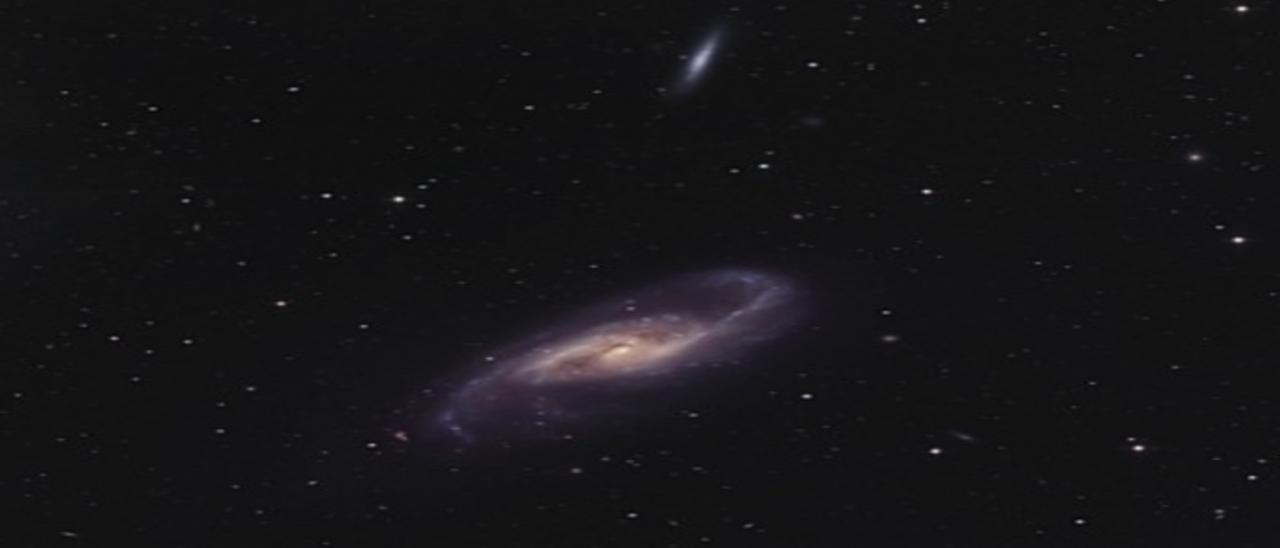Subvenciones relacionadas:
General
Nuestro grupo pequeño esta bien conocido y respetado internacionalmente por nuestro trabajo inovativo e importante en varios aspectos de la estructura y la evolución de las galaxias espirales cercanas. Usamos principalmente observaciones en varias longitudes de onda, explotando las sinergías que nos permiten responder a las cuestiones más pertinentes sobre las propiedades principales de las galaxias, y cómo las galaxias han evolucionado hasta su actual estatus. Usamos imagenes y espectroscopía, en el ultravioleta, óptico, infrarrojo, milimétrico y radio, usando al máximo las facilidades de observación a nuestra disposición en España, en la ESO y en otros sitios, combinando los datos con herramientas de análisis modernas. El éxito de esta forma de trabajar se puede medir de las oportunidades de trabajo que se presentan a los que fueron miembros del grupo, del número y de la calidad de las colaboraciones con científicos importantes, de las citas a nuestro trabajo, y de las invitaciones para organizar o hablar en los congresos más importantes en el campo.
En los últimos años nuestro grupo ha puesto mucho énfasis en abrir nuevas lineas de investigación conjuntas con informáticos, considerando el cambio de paradigma que está por venir debido a las enormes cantidades de datos que pronto producirán telescopios como LSST, Euclid, y SKA. Colaboramos con informáticos en la preparación de herramientas de análisis, incluyendo para la detección de estructura a partir del ruido, la corrección para la luz dispersa y el cirro de nuestra Vía Láctea, y el uso de técnicas basadas en machine learning. Así, una vez los telescopios LSST (2020) y Euclid (2023) empiezan a producir sus juegos de datos enormes, nuestro grupo estará preparado para analizarlos y extraer la ciencia.
Miembros
Resultados
- A partir de mapas térmicos y non-térmicos en radio del centro de NGC 1097 hemos descubierto que la formación de estrellas masivas se apaga por efectos non-térmicos, incluido la presión del campo magnético, rayos cósmicos y turbulencia.
- En el centro de NGC 7742 hemos detectado un disco interno y dos componentes estelares: una población vieja que contra-rota con el gas, y una joven, concentrado en un anillo, que rota con el gas.
- Hemos re-analizadas nuestras imágenes profundas IR de discos gruesos para corregir por el point spread function (PSF) extendido, confirmando todos nuestros previos resultados y en particular confirmando la presencia de una masa significativa en el componente del disco grueso.
- Analizando un mapa nuevo a alta resolución en el radio continuo a 1.5 GHz de e-Merlin, junto con imágenes de HST y SDSS de NGC 5322, una galaxia elíptica que contiene chorros en radio, hemos encontrado que un chorro de baja luminosidad puede haber acabado con la formación estelar en el nucleo.
- A partir de observaciones con MUSE de la emisión Lyman-α a bajo brillo superficial alrededor de galaxias débiles a redshifts entre 3 y 6 hemos encontrado que la cobertura proyectoada en el cielo se aproxima al 100%.
Actividad científica
Publicaciones relacionadas
-
Nuclear Rings in Galaxies—a Kinematic Perspective
We combine DensePak integral field unit and TAURUS Fabry-Perot observations of 13 nuclear rings to show an interconnection between the kinematic properties of the rings and their resonant origin. The nuclear rings have regular and symmetric kinematics, and lack strong non-circular motions. This symmetry, coupled with a direct relationship between
Mazzuca, Lisa M. et al.Fecha de publicación:
102011 -
Near-infrared atlas of S0-Sa galaxies (NIRS0S)
We present an atlas of Ks-band images of 206 early-type galaxies, including 160 S0-S0/a galaxies, 12 ellipticals and 33 Sa galaxies (+ one later type). The majority of the atlas galaxies belong to a magnitude-limited (mB ≤ 12.5 mag) sample of 185 Near-InfraRed S0 Survey galaxies. To ensure that misclassified S0s are not omitted, 25 ellipticals from
Laurikainen, E. et al.Fecha de publicación:
122011 -
Mid-infrared Galaxy Morphology from the Spitzer Survey of Stellar Structure in Galaxies (S4G): The Imprint of the De Vaucouleurs Revised Hubble-Sandage Classification System at 3.6 μm
Spitzer Space Telescope Infrared Array Camera imaging provides an opportunity to study all known morphological types of galaxies in the mid-IR at a depth significantly better than ground-based near-infrared and optical images. The goal of this study is to examine the imprint of the de Vaucouleurs classification volume in the 3.6 μm band, which is
Buta, Ronald J. et al.Fecha de publicación:
92010 -
Do Bars Drive Spiral Density Waves?
We present deep near-infrared Ks -band Anglo-Australian Telescope Infrared Imager and Spectrograph observations of a selected sample of nearby barred spiral galaxies, including some with the strongest known bars. The sample covers a range of Hubble types from SB0- to SBc. The goal is to determine if the torque strengths of the spirals correlate
Buta, Ronald J. et al.Fecha de publicación:
52009 -
Decreased Frequency of Strong Bars in S0 Galaxies: Evidence for Secular Evolution?
Using data from the Near-Infrared S0 Survey of nearby, early-type galaxies, we examine the distribution of bar strengths in S0 galaxies as compared to S0/a and Sa galaxies, and as compared to previously published bar strength data for Ohio State University Bright Spiral Galaxy Survey spiral galaxies. Bar strengths based on the gravitational torque
Buta, R. et al.Fecha de publicación:
92010 -
Bars, Ovals, and Lenses in Early-Type Disk Galaxies: Probes of Galaxy Evolution
The origin of S0 galaxies is discussed in the framework of early mergers in a cold dark matter cosmology, and in a scenario where S0s are assumed to be former spirals stripped of gas. From an analysis of 127 early-type disk galaxies (S0-Sa), we find a clear correlation between the scale parameters of the bulge (r eff) and the disk (h R), a
Laurikainen, E. et al.Fecha de publicación:
22009 -
Bars do Drive Spiral Density Waves
Recently, Buta et al. examined the question "Do Bars Drive Spiral Density Waves?", an idea supported by theoretical studies and also from a preliminary observational analysis. They estimated maximum bar strengths Qb , maximum spiral strengths Qs , and maximum m = 2 arm contrasts A 2s for 23 galaxies with deep Anglo-Australian Telescope (AAT) Ks
Salo, H. et al.Fecha de publicación:
52010 -
A pilot study for the SCUBA-2 `All-Sky' Survey
We have carried out a pilot study for the Submillimetre Common-User Bolometer Array 2 (SCUBA-2) ‘All-Sky’ Survey (SASSy), a wide and shallow mapping project at 850 μm, designed to find rare objects, both Galactic and extragalactic. Two distinct sets of exploratory observations were undertaken and used to test the SASSy approach and data-reduction
MacKenzie, Todd et al.Fecha de publicación:
82011 -
A Connection between Star Formation in Nuclear Rings and Their Host Galaxies
We present results from a photometric Hα survey of 22 nuclear rings, aiming to provide insight into their star formation properties, including age distribution, dynamical timescales, star formation rates, and galactic bar influence. We find a clear relationship between the position angles and ellipticities of the rings and those of their host
Mazzuca, Lisa M. et al.Fecha de publicación:
22008 -
The SAURON project - XVIII. The integrated UV-line-strength relations of early-type galaxies
Using far-ultraviolet (FUV) and near-ultraviolet (NUV) photometry from guest investigator programmes on the Galaxy Evolution Explorer (GALEX) satellite, optical photometry from the MDM Observatory and optical integral-field spectroscopy from SAURON, we explore the UV-line-strength relations of the 48 nearby early-type galaxies in the SAURON sample
Bureau, Martin et al.Fecha de publicación:
72011 -
The central region of M83: massive star formation, kinematics, and the location and origin of the nucleus
We report new near-IR integral field spectroscopy of the central starburst region of the barred spiral galaxy M83 obtained with Cambridge Infra-Red Panoramic Survey Spectrograph (CIRPASS) on Gemini-South, which we analyse in conjunction with GHαFaS Fabry-Perot data, an Anglo-Australian Telescope (AAT) IRIS2 Ks-band image, and near- and mid-IR
Knapen, J. H. et al.Fecha de publicación:
102010 -
Stellar Kinematics in Double-Barred Galaxies: The σ-Hollows
We present SAURON integral-field stellar velocity and velocity dispersion maps for four double-barred early-type galaxies: NGC 2859, NGC 3941, NGC 4725, and NGC 5850. The presence of the inner bar does not produce major changes in the line-of-sight velocity, but it appears to have an important effect in the stellar velocity dispersion maps: we find
de Lorenzo-Cáceres, A. et al.Fecha de publicación:
92008 -
Grand Design and Flocculent Spirals in the Spitzer Survey of Stellar Structure in Galaxies (S4G)
Spiral arm properties of 46 galaxies in the Spitzer Survey of Stellar Structure in Galaxies (S4G) were measured at 3.6 μm, where extinction is small and the old stars dominate. The sample includes flocculent, multiple arm, and grand design types with a wide range of Hubble and bar types. We find that most optically flocculent galaxies are also
Elmegreen, Debra Meloy et al.Fecha de publicación:
82011 -
Early-type Galaxies with Tidal Debris and Their Scaling Relations in the Spitzer Survey of Stellar Structure in Galaxies (S4G)
Tidal debris around galaxies can yield important clues on their evolution. We have identified tidal debris in 11 early-type galaxies (T
Kim, Taehyun et al.Fecha de publicación:
72012 -
A SINFONI View of Galaxy Centers: Morphology and Kinematics of Five Nuclear Star Formation-Rings
We present near-infrared (H- and K-band) integral-field observations of the circumnuclear star formation rings in five nearby spiral galaxies. The data, obtained at the Very Large Telescope with the SINFONI spectrograph, are used to construct maps of various emission lines that reveal the individual star forming regions ("hot spots") delineating
Böker, Torsten et al.Fecha de publicación:
22008 -
The Chandra COSMOS Survey. III. Optical and Infrared Identification of X-Ray Point Sources
The Chandra COSMOS Survey (C-COSMOS) is a large, 1.8 Ms, Chandra program that has imaged the central 0.9 deg2 of the COSMOS field down to limiting depths of 1.9 × 10-16 erg cm-2 s-1 in the soft (0.5-2 keV) band, 7.3 × 10-16 erg cm-2 s-1 in the hard (2-10 keV) band, and 5.7 × 10-16 erg cm-2 s-1 in the full (0.5-10 keV) band. In this paper we report
Civano, F. et al.Fecha de publicación:
82012 -
Spiral Inflow Feeding the Nuclear Starburst in M83, Observed in Hα Emission with the GHαFaS Fabry-Perot Interferometer
We present observations of the nearby barred starburst galaxy M83 (NGC 5236), with the new Fabry-Perot interferometer GHαFaS mounted on the 4.2 m William Herschel Telescope on La Palma. The unprecedented high-resolution observations, of 16 pc FWHM-1, of the Hα-emitting gas cover the central 2 kpc of the galaxy. The velocity field displays the
Fathi, Kambiz et al.Fecha de publicación:
32008 -
Pattern Speeds of Bars and Spiral Arms from Hα Velocity Fields
We have applied the Tremaine-Weinberg method to 10 late-type barred spiral galaxies using data cubes, in Hα emission, from the FaNTOmM and GHAFAS Fabry-Perot spectrometers. We have combined the derived bar (and/or spiral) pattern speeds with angular frequency plots to measure the corotation radii for the bars in these galaxies. We base our results
Fathi, K. et al.Fecha de publicación:
102009 -
On the morphology of sigma-drop galaxies
Context: Local reductions of the stellar velocity dispersion in the central regions of galaxies are known as sigma-drops (σ-drops). Knowing the origin of these features can lead to better understanding of inner galactic dynamics. Aims: We present a sample of 20 σ-drop galaxies matched with a control sample of galaxies without σ-drop in order to
Comerón, S. et al.Fecha de publicación:
72008 -
On the Curvature of Dust Lanes in Galactic Bars
We test the theoretical prediction that the straightest dust lanes in bars are found in strongly barred galaxies, or more specifically, that the degree of curvature of the dust lanes is inversely proportional to the strength of the bar. The test uses archival images of barred galaxies for which a reliable nonaxisymmetric torque parameter (Q b) and
Comerón, S. et al.Fecha de publicación:
122009



